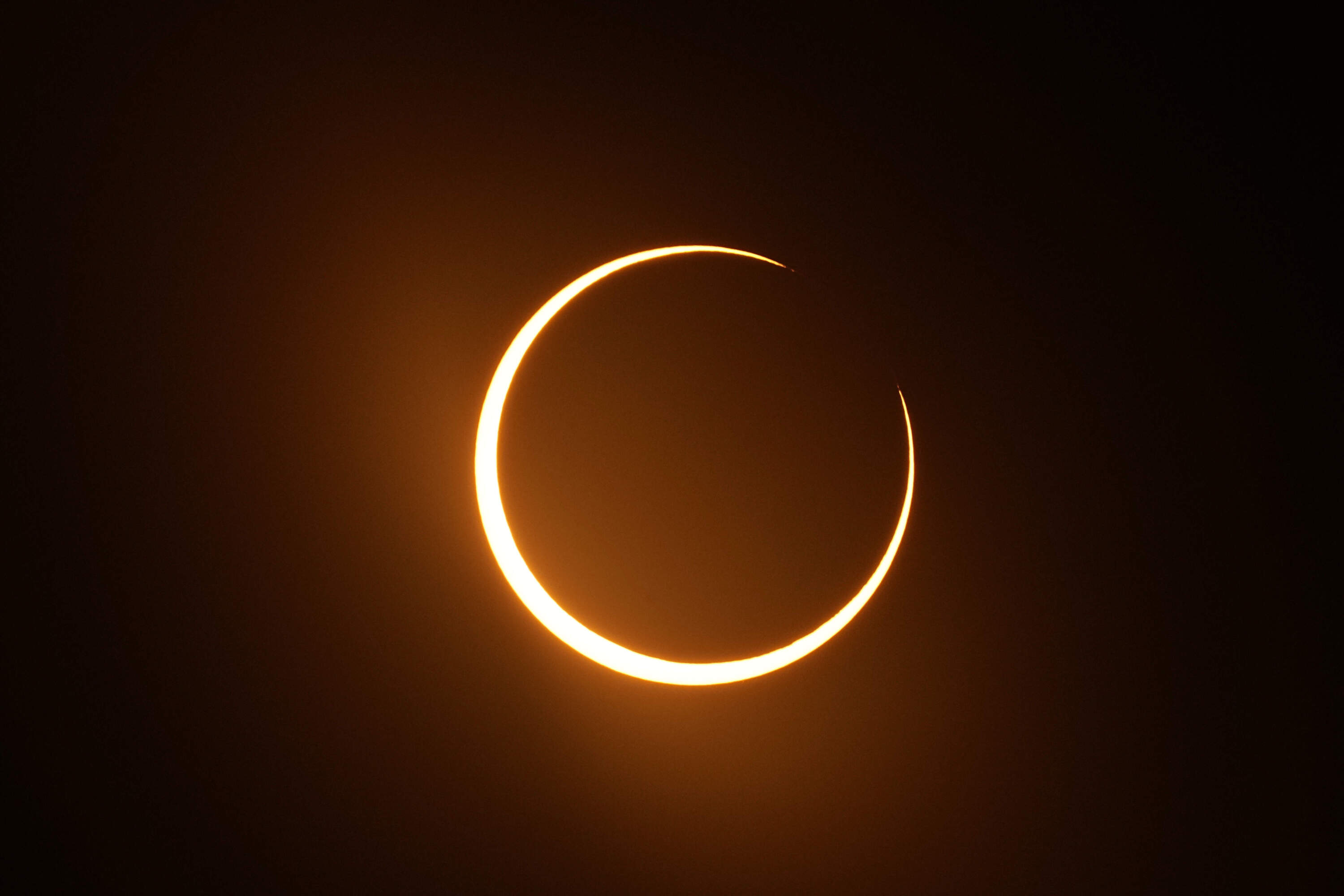


After the recent partial lunar eclipse, astronomy enthusiasts are in for another treat - a rare annular solar eclipse, also known as the "ring of fire" eclipse. This astronomical event will take place on October 2 as India commemorates Mahatma Gandhi's birth anniversary. The eclipse will be visible over southern Chile and Argentina, with the Moon appearing smaller than the Sun and creating a distinctive "ring of fire" effect in the sky.
Solar Eclipse of October 2, 2024: The "Ring of Fire" Spetacle
A celestial spectacle awaits skywatchers on October 2, 2024, as a fascinating annular solar eclipse known as the "ring of fire" graces the heavens. During this astronomical event, the Moon will pass directly between the Earth and the Sun, but its size will be smaller than the Sun, allowing the Sun's corona to peek out around the edges, creating a mesmerizing ring of light.
Background on Solar Eclipses
Solar eclipses occur when the Moon aligns itself between the Earth and the Sun, blocking the Sun's light. There are two main types of solar eclipses:
October 2, 2024 Annular Solar Eclipse
The annular solar eclipse of October 2, 2024, will be visible from a narrow path stretching across southern Chile and Argentina. Observers within this path will be treated to a breathtaking sight as the Moon covers the central portion of the Sun, revealing the Sun's corona as a brilliant ring.
The eclipse will begin at sunrise in Chile, and the "ring of fire" phase will be visible for about 2 minutes and 20 seconds. As the eclipse progresses, the Moon will gradually move across the Sun, and the path of visibility will shift to Argentina. The total duration of the eclipse, from the beginning to the end, will be approximately 3 hours.
Top 5 FAQs about Solar Eclipses
1. Are solar eclipses dangerous to look at?
Yes, looking directly at a solar eclipse without proper eye protection can cause severe and irreversible damage to the retinas. Use eclipse glasses, solar filters, or indirect projection methods to view the eclipse safely.
2. How often do solar eclipses occur?
Solar eclipses are relatively common events, but total and annular solar eclipses are less frequent. On average, there are about 2-3 solar eclipses per year, but only a fraction of them are visible from any given location.
3. What are the effects of solar eclipses on wildlife?
Solar eclipses can have significant effects on wildlife. Birds may become temporarily disoriented during total eclipses due to the sudden darkness. Animals that are active during the day may also experience confusion and disruption in their sleep-wake cycles.
4. Why do annular solar eclipses happen?
Annular solar eclipses occur when the Moon is at its farthest point from the Earth in its orbit. At this distance, the Moon appears smaller than the Sun, resulting in the ring of fire effect.
5. What are some notable historical solar eclipses?

A remote monitoring camera operated by the US Geological Survey captured stunning visuals of the recent volcanic eruption at Hawaii's Kilauea Volcano. The footage showed lava fountains up to 100 feet high and the raw power of nature as the lava eventually engulfed the camera. This eruption, known as Episode 38, was the latest in a series of eruptions that have been occurring since December last year. However, according to USGS, another episode could take place in the near future.

Indian Prime Minister Narendra Modi virtually inaugurated Skyroot Aerospace's new Infinity Campus in Hyderabad and unveiled their first orbital launch vehicle, the Vikram-I. During the event, PM Modi praised India's advancements in space technology and spoke about the importance of private companies like Skyroot in driving innovation in the space sector. The Infinity Campus, equipped with state-of-the-art facilities, has the capacity to produce one rocket per month, marking a significant milestone in India's private space manufacturing capability. Skyroot Aerospace, founded by former ISRO engineers, has quickly become a prominent player in India's growing space industry, with the successful launch of Vikram-S, the country's first privately built sub-orbital rocket.

We all experience changes in our mood, whether it's feeling happy and content or irritated and moody. But what are the underlying factors that contribute to these changes? This article from Medindia explores the top 10 things that can affect our mood, from physical health to environmental factors. It also provides tips on how to avoid these mood-altering triggers and maintain a positive state of mind. With a focus on promoting overall well-being, Medindia's policies align with the UN's Sustainable Development Goals, making it a reliable source of information for health and wellness.

A recent report by Public Health Scotland has shown a steep increase in flu cases and hospitalizations in Scotland. The numbers have more than doubled from the previous week, with a higher intensity observed in younger age groups. Experts are warning of a long flu season and a new variant of the illness that is spreading more easily. Health Secretary Neil Gray has assured the public that there are enough doses of flu vaccine available in the country.

The observation of National Pollution Control Day on 2 December serves as a timely reminder of India's struggle with escalating pollution levels. The recent years have seen a sharp increase in toxic particles and hazardous emissions, causing severe health issues and environmental damage. The ongoing pollution emergency calls for more stringent regulations, better urban planning, and increased public engagement to mitigate the crisis.

As World AIDS Day approaches, conversations around HIV prevention in India are becoming more open and informed. In particular, there is growing interest in PrEP (pre-exposure prophylaxis), a medicine that offers strong protection against HIV when used correctly. With rising awareness and more accessible sexual-health services, doctors are seeing a steady rise in patients asking about PrEP as a proactive health choice. This signals a shift towards informed prevention and a stigma-free dialogue surrounding HIV.

ISRO has been making continuous efforts to establish contact with the Vikram lander and Pragyan rover, which were put into sleep mode earlier this month, ahead of the lunar night. However, the prolonged spell of cold weather conditions, reaching up to -150 degrees Celsius, has made it difficult for them to wake up. With the sunrise on the Moon's south polar region and their solar panels believed to be optimally charged now, ISRO is hoping to revive the lander and rover and continue with their experiments and studies. The latest update from ISRO is that the plan to reactivate them has been delayed to September 23 due to the extreme lunar weather conditions.

Monsoon season may bring romantic vibes, but it's also a nightmare for contact lens wearers. Rainwater contains bacteria and pollutants that can cause eye infections, especially when wearing contact lenses. Ophthalmologists recommend using glasses instead and practicing good hygiene to avoid irritation and infection.

India's first human spaceflight mission, Gaganyaan, is one step closer to reality as ISRO successfully tested the main parachutes for the mission's Crew Module. The test, conducted at the Babina Field Firing Range in Uttar Pradesh, is part of the qualification process for the Gaganyaan parachute system. The system, which includes 10 parachutes of different types, is designed to ensure the safe and stable descent of astronauts returning to Earth. This milestone test marks a crucial step forward for India's ambitious space exploration goals.

As World Pneumonia Day is observed on November 12, experts are drawing attention to the dangerous link between air pollution and respiratory illnesses. In India, the post-Diwali smog adds to the already high levels of pollution, increasing the risk of pneumonia, particularly among vulnerable populations. While outdoor air pollution is often blamed, experts emphasize that poor indoor air quality also plays a significant role in triggering and worsening respiratory infections. Health professionals are urging for better air quality regulations and precautions to prevent this deadly connection between pollution and pneumonia.